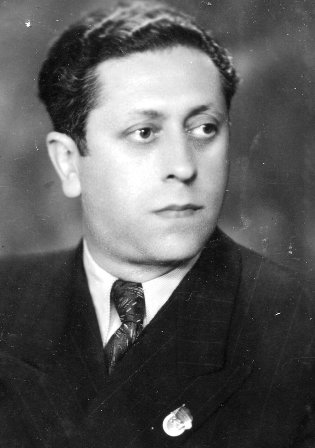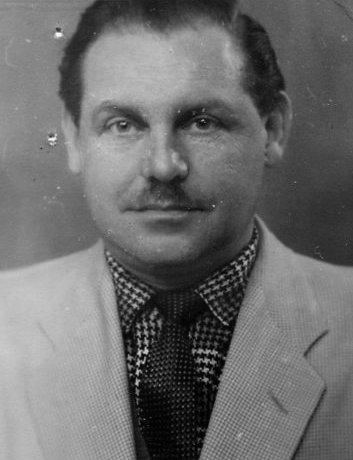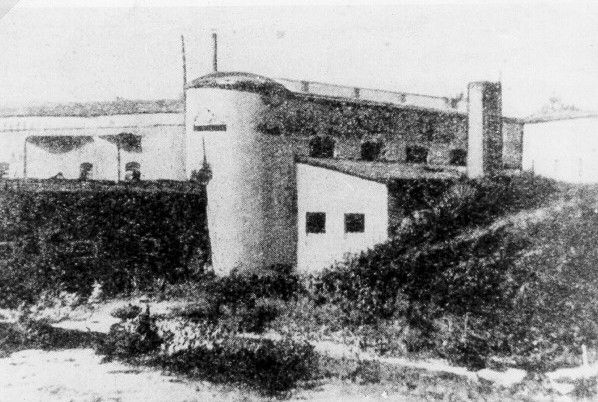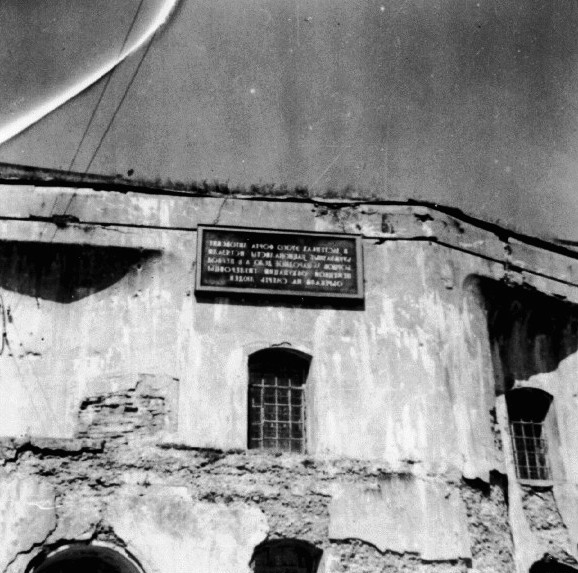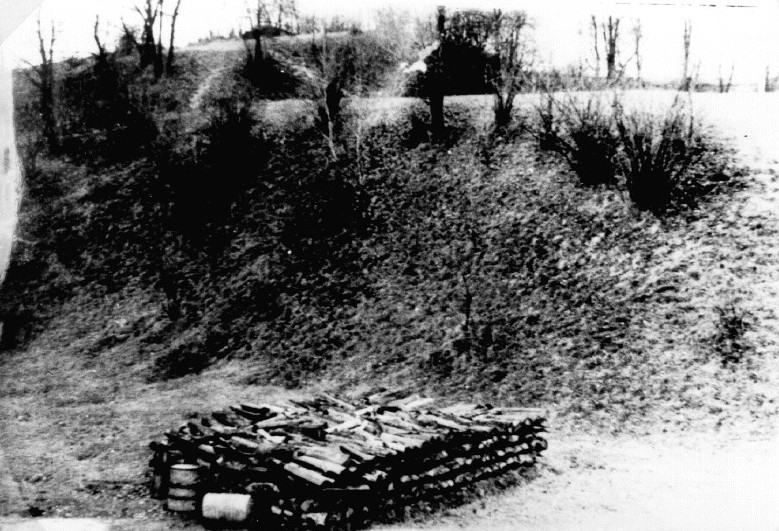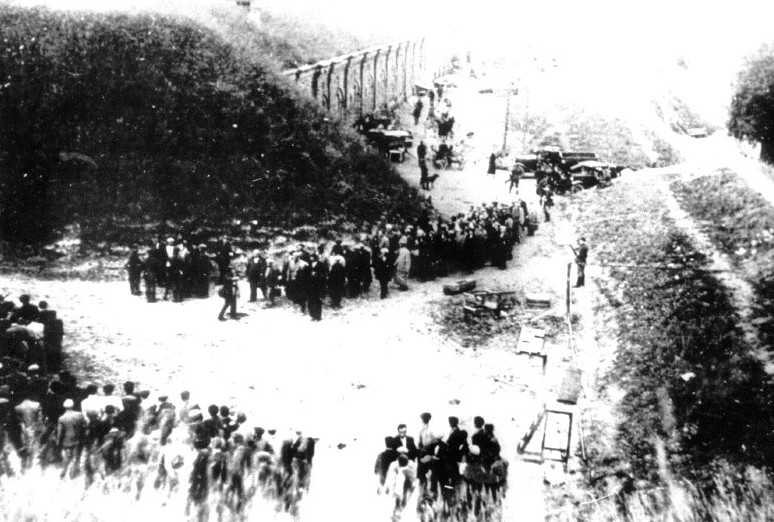Holocaust Education & Archive Research Team |
Revolt & Resistance
Acts of Resistance
Jewish Resistance
Groups Jewish Resistors Allied Reports Anti-Nazi Resistance Nazi collaborators
| ||||
The Gelpernus Diary Resistance in the Kovno Ghetto Chaim Yelin & Dimitri-Ghelpernus
Part V "Death to the invaders"
4.TOWARDS THE GROUP .
The organization had new hopes after it had established direct link to the secretary of Southern Underground Committee of the Lithuanian Communist Party and the head of the partisan movement in Vilno, Trakai, Alitus and other districts, comrade Heinrich Zimanas (underground alias "Jurgis") who was an experienced party activist and fighter for the Soviet rule in Lithuania. Comrade Ziman gave orders to send partisans from Kovno ghetto to Rudnizky forest and namely to the new group "Death to Invaders".
After a failure in August forest, people in the ghetto became even more convinced they needed an experienced guide to overcome difficulties of a long trip. Three partisans were sent from group "Death to Invaders" in the middle of November with varied tasks. On their return journey they were to bring with them a group of fighters from Kovno ghetto.
Having overcome many obstacles members of Kovno ghetto organization prepared for departure with the partisans gathered at a designated place in Murava. On November 23 the first group headed by communist Elia Olkin and Moishe Upnizky left Kovno for Rudnizky forest. Among their belongings there was a radio.
Their journey to the base was hard and long. The enemy was guarding all roads. In every small settlement there was a German garrison. The partisans lost a number of their friends. Commanding officer was killed, wounded Upnizky was returned to the ghetto. Only a small group of partisans reached the base.
The first march to Rudnizky forest taught partisans some good lessons. It became obvious that only a few individuals would be able to break through the blockade around Kovno and then march for another 150-160 kilometres on foot. For group passage one needed a different route. It was suggested to make the first and most dangerous part of the journey by a vehicle. It would have also allowed a bigger group of up to 30-35 men to be sent simultaneously which would be greeted by the younger generation who wished to join partisans.
With a great deal of effort a reliable lorry driver was found who had agreed to take the Jews (who also happened to be partisans!) The sending off was planned for December 12. The fighters gathered at a designated place and at the agreed hour. Guides were waiting at their designated place in the town. But the driver failed to get out of the garage of the German office which owned the vehicle. The fighters ready for departure had to change their combat gear for normal clothes of the ghetto residents, to hide their weapons and to avoid other residents. The next day the whole story was repeated. Only on December 14 the lorry appeared at the ghetto gates. The driver waited for a column of German vehicles to enter the ghetto,joined them and then drove to a side street in the ghetto.
The selected fighters gathered in safe flats. Messengers rounded all the fighters for the departure. The partisans quickly took up their places in the lorry. Thanks to the help of some members of the ghetto administration documents were obtained which suggested that the group were sent to work out of town. In case of a check up at the gates two fighters, Zundl Shtrom and Leiser Zodikov were dressed in German uniform. At approximately 7 pm the lorry successfully passed through the ghetto gates and the journey began. 8 kilometres out of Kovno the group expected to meet some guides but there was no one there.
They waited for over an hour. There were many German vehicles on the road. The situation was getting serious. Suddenly Haim Yelin who was accompanying the group noticed some Germans with a prisoner. It was dark. Yelin ordered the driver to direct headlights at that group, jumped off the lorry and approached the group. As it turned out they were the guides who in disguise managed to fool German patrol-men and to stay on the road for a long time. Three of the guides got into the lorry and it took the group to a place called Onushkis (110 kilometres from Kovno). The lorry returned to the city by morning time. The most dangerous part of the journey, railway line Vilno-Grodno guarded by fascists, the partisans made on foot and then successfully covered remaining 40 kilometres to the base of the group "Death to Invaders".
5. TO PARTISANS BY VEHICLES.
This successful attempt to get to the bases by a vehicle convinced the leadership that they should act in the same manner in the future. All activists began their quest for finding new vehicles and organizing further trips. Military instructors Haim-Dovid Ratner, Peisach Shater, Saul Finkel explained routes to the designated fighters, gave them last advice, checked and then gave arms, maps drafted by Moishe Aronson and Itzhack Minovsky, compasses made by Tevie Pilovnik. Doctor Rosa Golach and pharmacist Hasia Neviajskaia prepared and gave the partisans individual packets and medication and bandages for partisans' first aid box.
The majority of the group had worn out clothes and shoes on with wooden soles. Before their departure they received good leather boots, clothes and underwear. This became possible thanks to the work done by the equipment sector which was headed by two people: experienced Alta Teper and energetic and dependable Meer Grinberg. The latter put all his energy into the task of obtaining goods necessary for the future partisans. He also performed other tasks when it was required of him.
Leather and cloth were acquired by various means: from German storehouses, workshops, factories. On delivery necessary clothes was made from this. Every member of the organization tried hard to do all he/she could. Motl Goldschmidt, an excellent brush maker, found really good material which he used for making brushes, then sold ready made brushes and gave the money to the organization. Seamstress Hana Grinberg did the same with her slippers.
German greatcoats and other articles of clothing were delivered to ghetto workshops for repairs. Sara Friedman, Zilia Visgedriiskaia and others made jackets, trousers, gloves for the partisans. Sheina Levi organized making camouflage coats.
Ghetto workshops were a main source for obtaining footwear, clothes, bandoliers, holsters and other leather goods for the partisans. In daytime members of the organization brought out various materials while hiding it under their clothes. People were thoroughly checked every time they left a workshop. During those checks representatives of the Jewish administration were present. Among them there were organization sympathizers. On hearing a special password they helped the underground fighters to get through the check point...
Sending groups to partisans required money to buy weapons, to pay for the transport. Money was gathered from membership dues from underground fighters, people from "the periphery" , by selling personal belongings of those who left to join partisans. Judel Visgardiisky, Hana Bravo, Gena Messia were especially active in gathering funds.
The preferred method of leaving the ghetto in large groups was through the ghetto gates. It was done by passing the leaving groups for workers. Those members of the organization who worked in the ghetto police informed the rest of who was guarding the gates. Among those guards there were such men who lost their vigilance when a large group of people returned to the ghetto. Members of the organization used the opportunity: they caused even more havoc at the gates and at the same time gave false papers for signing which allowed new groups to leave the ghetto. Friends from the ghetto police - Haim-Dovid Ratner, Itzik Shater - smuggled weapons in bags intended for personal belongings.
After each group departure the organization had to arrange "removal" of names of the departed from the files of various ghetto administrative offices. It was vital to avoid the persons being put on the escapee list and to stop the police from victimizing their relatives and friends.
Committee members D.Galperin and Shimen Ratner were personally responsible for preparation and sending off. Comrades David Martkovsky, Meer Yelin, Moishe Muselis , Wolf Shavlan and others carried out special tasks connected with sending partisan groups.
Haim Yelin and Jankel Levi were responsible for the contacts with the city party organization during periods of transportation. They had to overcome serious difficulties. City underground fighters Trofimov and Paulavichus and ghetto messengers Mendl Moshkovich and Itzik Miklishansky were responsible for organizing transport for the groups.
The organization managed to send all in all eight armed groups to Rudnizky forest by various means. All these groups succeeded in reaching partisan bases without losses. The idea to use transport proved to be a winner.
Long moustache grown by those getting ready to leave for the forest in order to change their appearance and short jackets became a symbol of a partisan in the ghetto. It stopped being a secret for most ghetto residents that an opportunity existed which allowed them to join partisans. The hearts were filled with joy, hard days were made to appear easier thanks to the first signs of hope. In the ghetto a song was written addressed to the freedom fighters.( The author of the song was young girl Jashunskaia, who later joined partisan group "Forward").
Disappearance of hundreds of people from the ghetto could not have passed unnoticed. Friends and relatives, fellow workers, administration officers became aware. When the groups were leaving the ghetto outsiders were present at the gates. In spite of the fact that people saying goodbye were very careful about it and were supportive of the work done by the avengers, understandably the organization increased its strict conspiracy to safeguard the organization from traitors and provocateurs.
Kitel raged in the ghetto. He had already finished his bloody activity in Vilno - Vilno ghetto had been exterminated - and the Gestapo sent him to Kovno to make use of his "expertise in Jewish matters". Kitel did not hide his conviction that every ghetto had its own underground group. Thus, he issued an order to his assistants to search for such a group in Kovno ghetto. With this aim he tried to recruit help from ghetto Jews.
A certain Fain who shamelessly sold food at the black market was arrested during one of his "business deals" in the city. After a few days in gestapo he reappeared in the ghetto. The organization treated such people with suspicion. They began following Fain. The special sector of the organization was soon in the possession of facts confirming that the questionable luck of being returned to the ghetto was achieved by becoming a fascist agent.
During his visits to the ghetto Kitel called Fain several times. Judel Zupovich who served in the ghetto Jewish police and had contacts with the organization heard Kitel ask Fain about people who kept gold, weapons and other banned things in the ghetto. Serious accusations were confirmed by the following incident: once, unnoticed in the darkness, he crept into a lorry taking a group to the forest. While the lorry was moving he jumped off it - people in the lorry recognized him. The special court of the organization passed a guilty verdict and sentenced him to death. After the sentence was carried out (in a bunker where he was brought on false pretences) they found a piece of paper with Kitel's telephone number in the traitor's pocket.
Kitel searched tirelessly for Fain in the ghetto. Kitel demanded from the then chief of ghetto Jewish police Moishe Levin , who served the organization, to tell him into which well his (i.e. Kitel's) Fain was thrown... After this phrase many in the ghetto were expecting serious acts of repression. But the repressions came much later and in unusual form. The case of Fain was a warning - every traitor would be punished!
While groups were sent to the forest secrecy in the organization became relaxed. Leading figures were present at instruction sessions for those who were leaving, at weapons and clothes hand-outs, during passing through the gates. People for those groups were drawn from various units. Not only members of the organization joined partisan groups. The movement was reinforced by new people. Ghetto youth enthusiastically searched out possibilities to join partisans. The "periphery" of the organization had also widened. The organizational foundation thus somewhat changed.
Under those circumstances a reorganization took place - membership was reviewed, cells were restaffed and new secrecy rules were introduced. "Practical instructions to members' activities" were issued. New people were involved in the work of the leadership after the departure of the old members. So the committee membership changed several times before it became more or less stable for any considerable period of time: Haim Yelin -secretary and member responsible for communication and special issues; Dmitry Galperin - member responsible for agitation and propaganda work ( he also was Yelin's deputy performing Yelin's work when the latter was out of the ghetto liaising with the city organization);
Shimon Ratner - member responsible for military training and evacuation; Liusia Zimmerman was responsible for the membership and the organizational work; Meer Goldberg - responsible for financial and social issues; David Martkovsky was responsible for the work of the assistance sector.
6. 9th FORT
Starting from the beginning of November 1943 long tongues of flame could be seen from the ghetto every evening. North-westerly wind brought smell of burnt meat and bones...
Soon it became known that in the 9th fort they were burning bodies of people killed during the occupation. After Stalingrad Germans had a fear of retribution. They felt: the time was coming when they would have to answer for their bloody crimes. Wishing to sweep away any traces of their evil deeds fascists made a decision to open up mass graves and burn the remains. Kovno 9th fort had to be also "cleaned".
But the mystery of the 9th fort had long stopped being a mystery. Numerous living witnesses of German crimes were in and out of the ghetto. Farmers' houses were situated in a few hundred yards from the place of mass killings. Local residents saw with their own eyes how the doomed people were ordered to undress down to their underwear, made to approach pits into which they were thrown alive and then shot. Heart-rending scenes took place there. The cries of the poor souls could be heard everywhere.
The executioners hit people with the butts of their rifles, stabbed little children with their bayonets and then threw them into the pits. Farmer Vinzas Baniavichus told how one day a German covered in blood came running into his yard. His face was wounded, there were bites on his neck - results of an attack by one of the condemned Jews...
Only one man managed to escape alive during the times mass killings took place in the 9th fort. It was 11-year-old Itzik Bloch. He came running to the ghetto and told how he and his parents with many other Jews were taken from the ghetto to the 9th fort. There they were divided into small groups. They were made to get fully undressed in the snow, in the frost. They were taken to the pits. His mother started pushing him away," Run, run!"; he obeyed his mother and started running.
He was shot at but a bullet only slightly injured him. He fell into some bushes. When it became dark and the sounds of bullets and terrible cries died out the boy ran away from the terrifying place. In only his underwear, all covered in blood he managed to get through barbed wire into the ghetto.
Aron Gafanovich and Ruvim Gorgel who avoided being sent to the ghetto and happened to be in the vicinity of the 9th fort had a chance to watch one of the mass actions. Later, however, even more reliable witnesses came up who both lit up flames of bonfires in the 9th fort and shed light on what had happened there for the rest of the world. To carry out the obliteration of mass graves 72 people, mainly Jews from the ghetto and prisoners of war, were brought to the 9th fort.
The opening of the pits and burning of the remains proceeded in the following manner: the top soil was removed by excavators. A group of prisoners cleaned bodies of stuck soil. The next group removed bodies from the pits. There the bodies were inspected. A specially designated person (*doctor Neimionov) pulled out gold teeth. Pockets were also inspected. The next turn was for the carriers - they took the bodies to the bonfires. When the pit was emptied the Germans checked it and ordered to fill it up.
The bonfires for body burning was arranged in the following manner: logs were put in a 4H4 metres square. Underneath a channel was dug up which was filled with inflammable liquid. A layer of bodies was put onto a layer of logs, then another layer of bodies and another layer of logs. 300 (*according to more correct information - 250) bodies, a "norm" for each bonfire,were put together. To light up the fire several charges were put into the channel and then exploded. A bonfire would burn for 24 hours. The fire was seen several kilometres from the place and its smoke stretched out a long way. ...............................................................
In order to cover up their crimes in the 9th fort gestapo sent there a number of people who made the journey to the August forest but were captured by the police. Brought up in the spirit of struggle the members of the ghetto organization together with prisoners of war soon started forming a resistance group in the terrible conditions of the 9th fort.Comrades Moishe Simelevich and Alter Faitlson joined its leadership. Under Aron Vilenchuk and Tev'e Pilovnik's leadership a komsomol group began its actions. People put to burn bodies were eager to get out to tell the rest of the world about the atrocity. Their aim was an obvious one - to organize a mass break-out and to try and join a partisan group.
At the beginning it seemed to be impossible. Every morning people were put in irons in pairs before they left for work. The chains were removed only late in the evening in the basement cells of the old fortress, behind iron bars. There was no work in the fog. Quite by chance they found an old filled up well in one of the cells. A ray of hope appeared. In the night they began digging a tunnel in the well leading to the fortress exit. But after a short time they came against a stone wall. It was impossible to get through that obstacle. (*in fact, the prisoners could only clean out the well , but failed to get through its walls)
The prisoners started looking for other ways of escaping. After a long search it was established that at the end of the corridor there was an iron staircase leading to a dark passage. At the end of the passage there was an iron door after which there was a long tunnel full of logs.The tunnel to the northern outer wall of the fort.
However, further problems arose out of that: 1)the need to create a possibility to leave cells which were locked from the outside; 2)getting through the iron door; 3) removal of logs from the tunnel; 4)making a wooden ladder to overcome six-metre walls of the fort.
At first the problems appeared to be difficult to solve, but this did not undermine people's determination and they started the work.
Metal workers Pinhes Krakinovsky, Alter Faitlzon, Israel Ghitlin were often left in the casemate for work. Even in their shackles they could have some freedom of movement. The prisoners found keys to the cells and created an opportunity for one of them to get through a cell into the corridor.
With some drills they made a hole in the iron doors; in a dark and full of rubbish tunnel it was possible to do it without Germans' knowledge. In the evening after returning from "work" until "retreat" (at 8 pm) it was possible to drill more holes. In order to muffle the sound of drilling the prisoners always staged some sort of entertainment in their cells: singing, dancing, joking. The Germans did not interfere. On the contrary, they were pleased that the team was in high spirits, worked hard and increased daily "norms"... (*in fact, the hole in the iron door was drilled by Krakinovsky in daytime, who faked some illness: two prisoners had a right to be unwell and stay behind. The elder of the group decided who was going to be "unwell" - this was one of the break-out organizers Podolsky-Hailovsky).
And so the hole in the door was ready. Now it was the turn to clear the tunnel from the logs. They told Germans that in order to increase their turnover they needed dry logs - this is how they got the permission to take logs out of the tunnel. Shakhov who was working in the fort workshop made wooden parts (steps)for the cord ladder. Having put those parts together they made a ladder of the required length.
On Saturday, December 25 1943 at about 10 pm they began preparing for a mass break-out. The prisoners left their cells in strict order and complete silence. To muffle the sound of steps the iron stairs were covered with blankets and other cloth. Two of the leaders were in charge of people getting through the hole in the iron door. They held knives in their hands which were found on the dead bodies (*incorrect). As it was expected the guards were having a drinking party that night.
The inevitable noise created by the escapees was drown in the wild cries of the drinking guards (*in fact, it was dead calm that night!). 15 metres separated the iron door from the entrance to the underground tunnel where there used to be logs. This distance had to be covered with great care: there was some snow on the ground and the guard on the watchtower could notice the shadows.
Four people dressed in white clothes held a large white blanket made from several sheets. Under that cover groups of eight prisoners (*sixteen) made this most dangerous part of their journey. When they left the tunnel the fugitives found themselves at the edge of a deep ditch and having gathered all their strength they made their way down. The inner side of the ditch they had climbed with the help of the home‑made cord ladder. The last part of the obstacle in their way they had cut through with wire-cutters. The prisoners were at large...
The fugitives dispersed. One group went to the ghetto, among them 14 people from the ghetto organization and Soviet Army captain I.Vasilenko. With the help from the organization the fugitives were soon sent to a partisan base.
Only by the morning the fort administration realized that prisoners had escaped. All Kovno police, SS, gestapo and some army units were put into a search party. All territory around the 9th fort and Kovno suburb of Villiampole where the ghetto was situated were thoroughly searched. The Germans threatened the ghetto with extermination unless they handed back the escapees from the 9th fort. Only after a group of fugitives had been recaptured in different parts of the city and its suburbs gestapo people believed that none of the fugitives had managed to return to the guarded ghetto.
The organization hid those fugitives of the 9th fort who managed to get back into the ghetto in its bunkers. Medical help was given to those who needed it.Alta Teper put a bandage on metal-worker Pinhes Krakinovsky: because of the inhumane effort put into drilling holes he lost skin on his fingers...(* this seriousness of his condition has been exaggerated).
There was a terrible smell coming from the former "body-burners"' clothes. There was a danger of gestapo dogs finding the hide-out by that smell; "fort uniforms" were immediately burnt and the fugitives got new clothes after a wash.
There was urgency about preparing fugitives from the 9th fort for departure to the partisans. On January 6, 1944 together with their friends from the organization the fugitives set out for the forest by lorry. When they were passing through Onushkis, 100 kilometres from Kovno, local police tried to stop them. Thanks to Yelin's experience and sense of direction (he accompanied the vehicle) they succeeded in getting through a police cordon and hide in the night darkness before the police could take any action. The group successfully arrived at the partisan base.
% % %
Among documents taken by the group to the forest was a copy of the act describing German atrocities in the 9th fort. This act was compiled by the fugitives during their stay in the ghetto. The second copy was kept in the ghetto archives. Below is the text of the act:(* the text is given from the original without any changes)
A c t Kovno. December 26, 1943
We, the undersigned, prisoners from the 9th fort, Kovno having escaped the imprisonment on the night of December 26 of this year, including Vesel'nizky I.L.(Vasilenko I.L.), Diskant A. (Vilensky), Faitelson A., Gelbtrunk M., Pilovnik A., Gempel B., Eidelson S., Maneisky A., wrote the following act:
1.In the period between 1941 and 1942 the territory of the fort was used by the German command to perform mass killings by shooting.
2.To hide this fact the German command represented by Kovno gestapo leadership organized opening up of the pits where bodies were buried and began burning of the remains.
3.To do this work gestapo brought 72 people to the 9th fort by end October- beginning of November of this year, among them: 34 prisoners of war (Jews) 14 partisans 3 Russians 4 women 17 ghetto Jews.
4.To avoid discovery of the nature of that work by the local population or other people the work was strictly organized; so notices were displayed in the radius of 2 kilometres forbidding approach at the threat of death. The place of work covering 2-3 hectares was surrounded by material. People working there were not allowed to leave the territory of the fort (one Jew who fell ill with appendicitis was shot dead on November 5th, and 7 prisoners of war, old aged and invalids, were shot on November 13 can serve as a proof ); thus, only 64 people remained at work.
5.During the work, i.e. from November 1 to December 25 of this year (the day of escape) 6.5 pits of 100-120 metres long, 3 metres wide and 1.5 metres deep were opened; 12,000 bodies of men, women and children were brought out. Those bodies were put into piles of 300 bodies in each and burnt. The remains of the fires (coal and bones) were turned into powder and mixed with soil to avoid leaving any traces.
6.To stop people from escaping during the work they were shackled in pairs. There was a watchtower with a submachine-gun, the guards had machineguns and pistols.
7.Among 12,000 burnt bodies there were 5,000 Jews brought from Vienna, Frankfurt-am-Mein, Dusseldorf, Hamburg and other German cities, small number of Jewish prisoners of war - 120-150 people some of whom were shot while others poisoned and about 7,000 Jews from Kovno. German Jews were shot and buried in clothes, others were undressed before being killed.
8.The position of the bodies in the pits suggested that people were brought there in groups, made to lie down in the pits, then they were shot at, as result of this action many were buried alive with or without wounds. The fact that many bodies were found without bullet wounds at all proves the point.
9.By the day of the escape 7.5 pits were left untouched. Gestapo leaders hoped to finish work by February 1, 1944.
10.Judging by the fact that in the first 6.5 pits 12,000 bodies were uncovered while 7.5 pits remained untouched we could draw a conclusion that 25-30 thousand victims of German atrocities inflicted on civilian population were buried in the 9th fort. The number 25-30 thousand victims was also mentioned in the conversations of the gestapo people overseeing the work. Signatures
(After the liberation of Kovno the State Commission examining facts of the German crimes established that in 1941-1944 over 70 thousand people were killed in the 9th fort. (*It is believed now that around 80,000 people died there.)
The fugitives from the 9th fort brought documents and some evidence with them: gold crowns which were extracted from the mouths of dead people, two drawings made by Soviet Jewish prisoner of war, Anatoly Gran. (*In a number of documents and memoirs about the 9th fort the surname of this person was mistakenly given as Garnik.) One of the drawings depicted two prisoners carrying a stretcher with bodies to the bonfire under guard. The second one was a sketch of a cartoon drawn by Gran on the door of his cell before the escape - it depicted a German being given a V-sign... (* The collection of crowns and both drawings can be found in the Lithuanian Museum of the Revolution in Vilnius.)
Minutes of the komsomol meetings taken place in the 9th fort were also brought to the ghetto. One of the points talked about a proposal to give comrade Aba Discant komsomol membership for his fighting spirit, serious attitude and comradeship shown in the severest circumstances.
Continued...
[Part 1] [Part 2] [Part 3] [Part 4] [Part 6] [Part 7] [Part 8]
Sources: Chaim Bargman: translator Yiddish-Russian (L) with Robin O’Neil: translator Russian – English. Kaunas, Lithuania 2007 (photos: GFH, USHMM, & Private Collections)
Copyright H.E.A.R.T 2008 [Page design by Carmelo Lisciotto]
|
